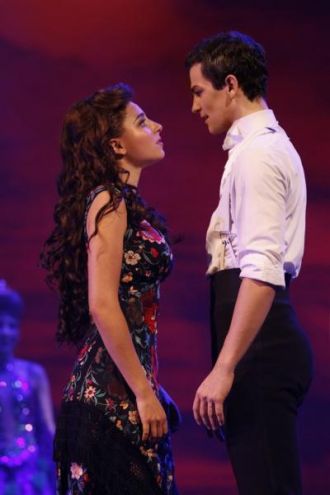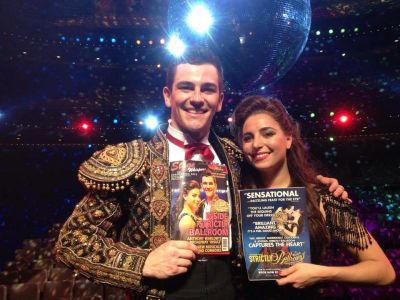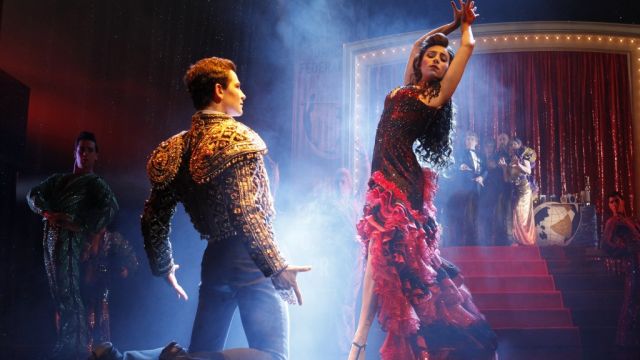Inside Strictly Ballroom The Musical
Audiences love it, but critics are luke-warm. David Spicer speaks to the writers of the musical, who confirm that changes are planned as it moves into new cities.
At the media call Baz Luhrmann was a little on edge. It was the day before the World Premiere and a vital ingredient was missing from the performance for the large media contingent.
“The most essential element in this production is the all singing, all dancing seats in the audience. People in those seats are cast in the roles of characters in the festivals. At the end of the production (if you have seen the film) the characters of the ballroom dancing world finally cross the line,” he said. “It is because of their rhythmic clapping that Scott and Fran are able to finish their steps, their choreography, and pursue their individual truthful road, rather than the one set down by the all-powerful Federation, who have a little book with all the ticks and crosses.”
Indeed the audience rarely forgets its ‘lines’ but sometimes the timing is out. The most common response is for the rhythmic clapping to start a little early – drowning out Barry Fife before the famous protest is due to begin.
As you can see from the cover of this edition the seats are also colour coded, helping to prompt members of the audience to barrack for their team at the appropriate time. If you are sitting near the front you can also dance on the stage after the curtain calls.
Co-writer Craig Pearce says the audience participation is one of the most popular aspects of the production.
“We are getting people dancing and cheering on stage and in the aisles at the end. We really feel like they are with us. I have heard reports that people want to come back. It’s an experience like The Rocky Horror Show.”
Pearce was with Baz Luhrmann at NIDA when they first wrote the 30 minute play edition of Strictly Ballroom and was also the co-writer of the screenplays for Romeo +Juliet, Moulin Rouge and The Great Gatsby, but he says developing a musical is a very different dance to master.
“I have learnt just how important music has to be as a storytelling device. You can’t just put songs between scenes. The music has to be an intrinsic part of the storytelling and has really got to drive the storytelling.

“Something that surprised me was how much further you could go with storytelling devices in writing a musical than with a film.”
He compares a scene in the movie where ballroom dancing supremo Barry Fife warns a character that Scott has to dance by the rules, otherwise there will be severe repercussions with his career and life.
In the musical it “becomes a big sort of Russian Stalin era showstopper that has echoes of any kind of Fascist regime. We went quite a long way with that, with Russian dancers in ‘blinged’ out caps and doing Russian goosestepping.”
Craig Pearce says audiences are very willing to participate in the heightened theatricality of it as long as the intrinsic storytelling idea is clear.
Another example is a number called ‘Heavenly Pineapple’, sung by the character of Tina Sparkles.
“She is supposedly dancing a farewell exhibition dance with her partner Nathan Starkey. Within a few bars she is singing to Scott about the power of her pineapple and all the right cherries he can pluck if he comes and dances with her.
“It is a tricky reference to Carmen Miranda and that kind of crazy choreography of the 40’s. On one hand we are saying Federation style of dancing does not have a lot of soul to it, but it is very glitzy and attractive on the surface, whereas the dancing of Scott is a lot deeper.”
The full name of the song is ‘State Championship – Heavenly Pineapple’ and according to the program it was composed by six people and written by another four. Whatever happened to the days of Rodgers and Hammerstein sitting around a piano and eking out a song?
“It was originally a track submitted by Sia Furler. Pop music is very collaborative these days. Someone would have done the top line, someone the bass and maybe a rhythm bed. We then worked out where it would be great in the show.
“There is also some traditional songwriting in there (including Eddie Perfect’s songs), written by one or two people around the piano.”
The songs in the musical are from many different genres. There is an adaptation of a classic waltz, a re-write of a song from Carmen, a techno song and classic pop such as ‘Time after time’ and ‘Love is in the air’. Craig Pearce says this has a lot of appeal to young people.
“The ballroom world is a very eclectic world musically. It is something that intrinsically makes sense in the world of ballroom dancing and gives an energy to the show that I really like.
“There is a real move towards bower birding from different cultures and genres and putting them together to create new ones.”
 Baz Luhrmann himself is credited with writing the lyrics or co-composing eighteen of the songs. Craig Pearce says that Baz has long been a contributor to the music in his films.
Baz Luhrmann himself is credited with writing the lyrics or co-composing eighteen of the songs. Craig Pearce says that Baz has long been a contributor to the music in his films.
It poses the question, how does Baz Luhrmann as the Director of the musical look critically at his own work, as it is unusual for a director of a new musical to also be one of the major writers of the dialogue, lyrics and music. In this case the story is also very close to him as it was inspired by his childhood.
“Baz has a history of surrounding himself with talented people who are simpatico with him in terms of communication and working together. It is not like he is a mad megalomaniacal tyrant surrounding himself with yes people. He is very good at creating a creative team that he relies on.
“It is a challenge for any person of an auteur nature as he is involved in just about all the aspects of the production. At the end of the day he has the over-riding say, but he is very good at listening to people he is collaborating with.”
Many of the critics have not been kind to the musical. Firstly there was consternation within the company when a blogger chose to publish his opinion based on the second preview.
“I am sure Baz did read it. It is unfair for a show to be reviewed in a preview but I guess with social media, everyone is a critic. People that scream the loudest get the most attention so they can say.”
Later the official reviews rolled in and several leading critics expressed disappointment with the original music.
“It sounds pretentious. I know we’ve had some amazing reviews, mixed reviews and bad reviews. I don’t read (any).
“A wise old actor once said to me, he that lives by the reviews dies by the reviews. I am not interested in spending the energy on it.
“If someone writes a good review. Wow they really like me! Then someone writes a bad review then they don’t understand it. Whether or not the view is valid you expend a certain amount of emotional energy on that. That’s not for me.”
But Craig agrees there is room for improvement.
“These shows have a long, long life. They have a long development. One of the exciting things is you do have the opportunity to improve it and change it, which you don’t with film. It is never perfect. We will certainly tweak it before Melbourne and before London and any version of it. That is the nature of who we are as creative people.”
Changing musicals once they have opened is nothing new. Industry insiders say Priscilla Queen of the Desert was a mess for the first three months it was on in Sydney and went on to be staged all over the world.
Strictly Ballroom The Musical has already been trimmed by fifteen minutes or so during the previews.
Baz Lurhrmann says he learns the most from the audience.
“We had a standard preview period. You can hide away longer but then you discover your flaws too late.
“Wherever we go comment is going to follow. Our relationship has always been directly to the audience. I think hiding away feels better, you sleep more comfortably, but it is not the best or right thing to do.
“There is nothing more valuable than an audience in the creative process.

“We put in a lot of work into an aria by Scott after he loses at the Samba. It turned out lovely and had a lot of visual imagery that was engaging. It turns out we did not really know anything about Scott, we did not really care for that character (yet), so we ripped it out and the audience was engaged in a clearer way.
“You might say this is not a very out of town try out. We always live in a paradox because this is our home town. But there is a place called Broadway and that is a different playing field. This is an Australian musical. There are characters in it that are fundamentally Australian. It is good to have time to build in this environment.”
But Craig Pearce is not losing any sleep over the musical as it now stands. He’s planning on taking a break from it before trying to look at the production again with fresh eyes.
“I think the show is in a very strong place. You don’t get that kind of reaction from audiences unless there is a genuine love for the show.”
Strictly Ballroom The Musical had its World Premiere at Sydney's Lyric Theatre on April 12, 2014. A Melbourne season will commence at Her Majesty's Theatre in January 2014.
Production images by Jeff Busby. Stage Whispers promo image by David Spicer.
Article originally published in the May / June edition of Stage Whispers.
More Reading
Interview with Phoebe Panaretos (Fran) and Thomas Lacey (Scott)
Subscribe to our E-Newsletter, buy our latest print edition or find a Performing Arts book at Book Nook.

